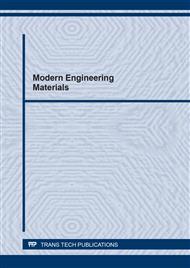[1]
Abishera, R.., et al., Reversible plasticity shape memory effect in carbon nanotubes reinforced epoxy nanocomposites, Composites Science and Technology,137 (2016) 148-158.
DOI: 10.1016/j.compscitech.2016.10.030
Google Scholar
[2]
Leng, J. S., X. L. Wu., Infrared Light-Active Shape Memory Polymer Filled with Nanocarbon Particles,, Journal of Applied Polymer Science,114: 2455-2460, (2009).
DOI: 10.1002/app.30724
Google Scholar
[3]
Sahoo, N. G., Y. C. Jung. Conducting shape memory polyurethane-polypyrrole composites for an electroactive actuator, Macromolecular Materials and Engineering, 290 (2005) 1049-1055.
DOI: 10.1002/mame.200500211
Google Scholar
[4]
Huang, W. M., Yang, B., Water-driven programmable polyurethane shape memory polymer: Demonstration and mechanism, Applied Physics Letters,86 (2005) 1-7.
DOI: 10.1063/1.1880448
Google Scholar
[5]
Liu, C., H. Qin, and P. T. Mather. Review of progress in shape-memory polymers, Journal of materials chemistry, 17 (2007) 1543-1558.
Google Scholar
[6]
Ota S, Current status of irradiated heat-shrinkable tubing in Japan. Radiation Physics and Chemistry, 18 (1981) 81–87.
DOI: 10.1016/0146-5724(81)90066-2
Google Scholar
[7]
Lendlein, A., and Langer, R., Biodegradable, elastic shape-memory polymers for potential biomedical applications, Science, 296 (2002) 1673–1676.
DOI: 10.1126/science.1066102
Google Scholar
[8]
Hu, J., and Chen, S., A review of actively moving polymers in textile applications, Journal of Materials Chemistry, 20 (2010) 3346–3355.
Google Scholar
[9]
Leng, J., et al., Effect of a linear monomer on the thermomechanical properties of epoxy shape-memory polymer, Smart Materials and Structures, 18 (2009).
DOI: 10.1088/0964-1726/18/9/095031
Google Scholar
[10]
Xie, T., and Rousseau, IA., Facile tailoring of thermal transition temperatures of epoxy shape memory polymers. Polymer 50 (2009) 1852-1856.
DOI: 10.1016/j.polymer.2009.02.035
Google Scholar
[11]
Abishera, R., et al., Free, partial, and fully constrained recovery analysis of cold-programmed shape memory epoxy/carbon nanotube nanocomposites: Experiments and predictions,. Journal of Intelligent Material Systems and Structures,26 (2018) 2164-2176.
DOI: 10.1177/1045389x18758187
Google Scholar
[12]
Kartikey Shahi, et al., Cold programming of epoxy-based shape memory polymer, Structures, 29 (2020) 2082-2093.
DOI: 10.1016/j.istruc.2020.05.023
Google Scholar
[13]
Huifeng Tan, et al Effect of Clay Modification on the Morphological, Mechanical and Thermal properties of Epoxy/Polypropylene/Montmorillonite Shape Memory Materials. Proc. of SPIE 8409 (2012) 84091z-1- 8091z-11.
DOI: 10.1117/12.923306
Google Scholar
[14]
RadeVignjevic, et al., Modelling of strain softening materials based on equivalent damage force,, Engenieering,335 (2018) 52-68.
Google Scholar
[15]
D. Ray, B.K. Sarkar, S. Das, A.K. Rana, Dynamic mechanical and thermal analysis of vinylester-resin-matrix composites reinforced with untreated and alkali-treated jute fibres, Compos Sci Technol,62 (2002) 911–917.
DOI: 10.1016/s0266-3538(02)00005-2
Google Scholar
[16]
W. Stark, Investigation of the curing behaviour of carbon fiber epoxy prepreg by Dynamic Mechanical Analysis DMA, Polymer Testing, 32 (2013) 231–239.
DOI: 10.1016/j.polymertesting.2012.11.004
Google Scholar
[17]
Ajay Sing Rana, et al Mechanical, thermal, electrical and crystallographic behaviour of EPDM rubber/clay nanocomposites for out-door insulation applications,, Advances in Materials and Processing Technologies,6 (2019) 54-74.
DOI: 10.1080/2374068x.2019.1703339
Google Scholar


